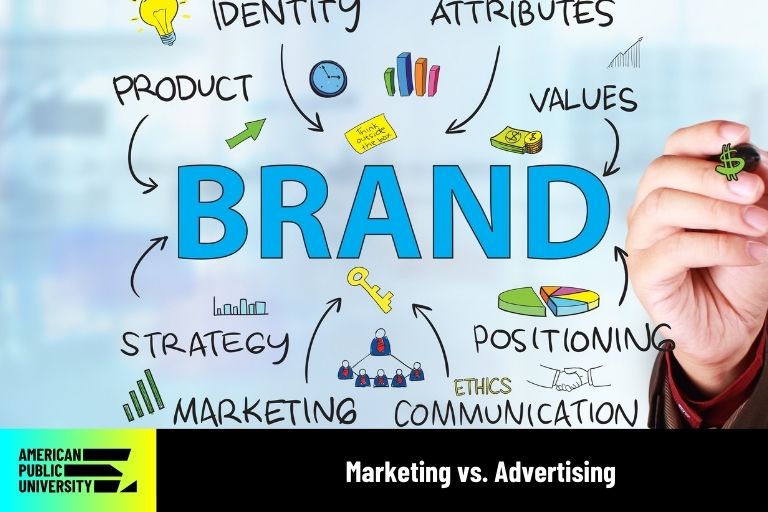04/23/2025

Marketing and advertising are often mentioned in the same breath, but while they work together, they serve distinct roles. Although these terms are often used interchangeably, understanding their differences is essential for navigating the broader field of marketing.
This guide outlines the key differences, provides examples, and examines how these concepts are taught in marketing-related programs.
What Is Marketing?
Marketing refers to the broader process of promoting, selling, and distributing products, services, or ideas. It involves identifying potential audiences, conducting market research, and exploring strategies to engage people in meaningful ways.
In academic settings, marketing is often presented as a long-term approach focused on building awareness, exploring audience behaviors, and examining how relationships between brands and consumers are developed. Areas of study may include:
- Content marketing
- General advertising campaigns
- Social media marketing
- Email marketing
- Public relations
- Search engine optimization (SEO)
- Relationship marketing
These topics illustrate how organizations aim to create value and remain relevant in a competitive environment.
What Is Advertising?
Advertising focuses on the paid promotion of a product, service, or message. It’s a component of marketing aimed at reaching specific audiences through media placements designed to increase visibility or drive action.
In coursework, advertising is often introduced as a tactical element within a larger marketing plan. Examples include:
- Paid media (e.g., pay-per-click and digital ads)
- Ad campaigns
- Search engine advertising
- Video and display ads
- Social media ad placements
While marketing emphasizes long-term strategy, advertising is often explored for its more immediate impact—like generating clicks, conversions, or brand recognition.
Key Differences Between Marketing and Advertising
To better understand the distinction between marketing and advertising, consider the following side-by-side comparison:
| Aspect | Marketing | Advertising |
|---|---|---|
| Definition | A broad business function that involves research, strategy, branding, and customer engagement. | A component of marketing that focuses on paid promotional efforts. |
| Goal | Establish long-term customer relationships and build brand awareness. | Drive immediate sales and boost sales promotions. |
| Methods | Content marketing, SEO, relationship marketing, social media marketing. | Display advertising, search engine marketing, mobile advertising, and traditional media ads. |
| Approach | Ongoing process involving owned media, customer engagement, and branding. | Paid campaigns focused on ad placement and lead conversion. |
| Example | A company publishes valuable blog posts to educate customers about its industry. | The same company runs a Facebook ad campaign to promote a specific product. |
Types of Marketing and Advertising
Marketing involves a wide range of approaches that are applied across different industries to connect with target audiences. These reflect common categories discussed in academic programs and projects.
Types of Marketing
- Digital Marketing – Covers SEO, social media, email, and other online tools.
- Content Marketing – Focuses on blogs, videos, podcasts, or infographics.
- Influencer Marketing – Collaborates with content creators to expand reach.
- Relationship Marketing – Looks at long-term engagement and customer loyalty.
- Global Marketing – Considers how brands adapt strategies across regions.
- Retail Marketing – Examines marketing within physical or online store environments.
Types of Advertising
- Traditional Advertising – Includes print, broadcast, outdoor ads, and direct selling.
- Digital Advertising – Encompasses online platforms like Google Ads or Facebook Ads. Google Ads is a registered trademark of Google LLC. Facebook is a registered trademark of Meta Platforms, Inc.
- Mobile Advertising – Focuses on in-app ads, push notifications, and SMS marketing.
- Search Engine Advertising – Uses paid search placements, often via PPC models.
- Native Advertising – Integrates ads into content to match the surrounding format.
- Video Advertising – Appears on platforms like YouTube or streaming services.
- Retail Advertising – Uses in-store signage or digital displays to promote products.
These categories may help you explore how different formats are used to reach audiences across media platforms.
Planning Marketing and Advertising Strategies
Creating an effective marketing or advertising approach involves more than picking the right platform. In practice, marketing and advertising strategies are often developed through a process that involves research, planning, and ongoing evaluation to guide decision-making.
Step 1: Conduct Audience Research
Analyzing demographic trends, interests, and behaviors to better understand who a campaign is targeting.
Step 2: Develop a Marketing Plan
Outlining communication goals, messaging, and platforms. This may include content development, branding work, or community outreach.
Step 3: Choose the Right Advertising Methods
Reviewing available ad options based on budget, timeline, and audience preferences.
Step 4: Optimize Ad Placement and Spend
Studying tools like A/B testing or analytics dashboards to track how ads are performing and where adjustments might be needed.
Step 5: Track and Improve Marketing Efforts
Measuring things like social media engagement, click-through rates, or traffic from paid ads to assess strategy effectiveness.
Comparing Marketing and Advertising Degree Paths
Individuals pursuing a degree in marketing or advertising will likely notice some overlap—but there are also distinctions in focus.
- Marketing majors often study a wider range of business topics, including consumer behavior, branding, market research, and analytics.
- Advertising majors tend to dive deeper into creative strategy, campaign planning, media buying, and copywriting.
Both paths offer opportunities to examine how messages are shaped, distributed, and evaluated across industries.
Understanding How Marketing and Advertising Work Together
The comparison of marketing vs advertising highlights how each plays a distinct role in how brands communicate. While marketing involves a broader process—like audience research, branding, and long-term engagement—advertising focuses more narrowly on paid efforts that support specific goals. In many cases, advertising strategies are just one part of a larger, successful marketing strategy.
For those exploring these concepts, learning how each function operates—and how they complement each other—can offer insight into how real-world campaigns are developed and refined. Understanding how these elements interact may offer helpful context for analyzing how organizations build visibility, connect with audiences, and respond to changing trends.

